Korean Royal Court Cuisine food fit for a Queen’s 60th Birthday Party!! Join me for another amazing 8 course Royal Degustation Course at Jihwaja restaurant in Seoul.
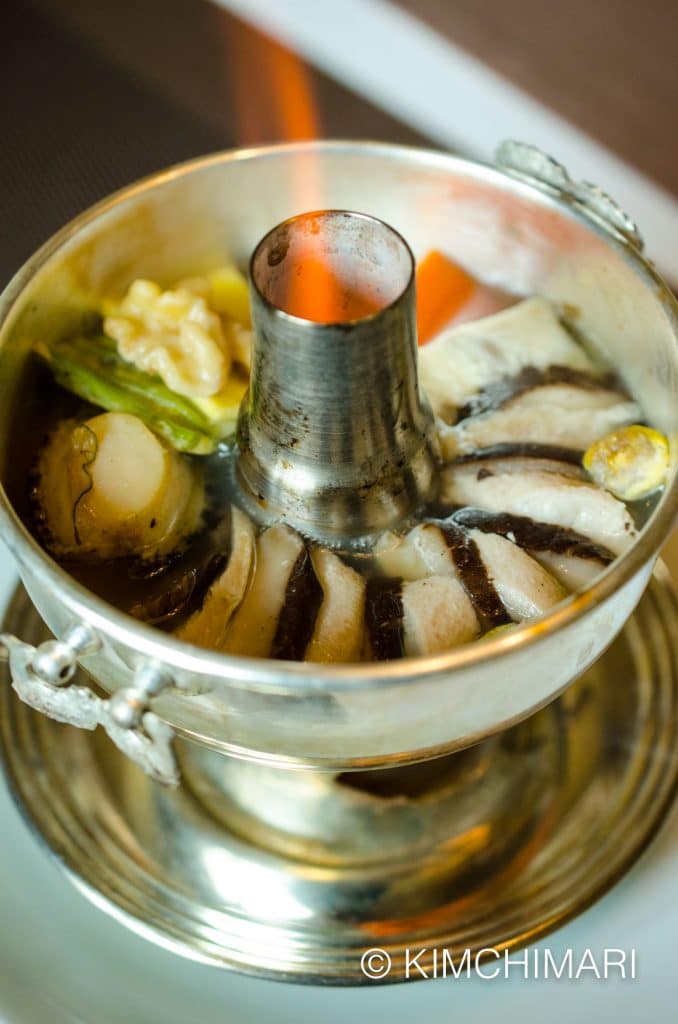
Korean Royal Court Cuisine ( 궁중음식 Gungjung Eumsik) meal that was reconstructed from the actual banquet menu for Queen mother of King Jeongjo at her 60th birthday party which was actually in 1795. That was what I was treated to – at Jihwaja 지화자 – during my most recent visit to Seoul.
Back in 2016, I wrote a post about my visit to Jihwaja with my friend Insook. It was the first time I was treated to a full Korean royal court cuisine meal and I was so impressed that I wrote a long post about it. Well, few months ago, Mr. Hwang who is the director of the restaurant, sent me email to let me know how much they appreciated my post and how it was bringing many foreigners to their Jihwaja restaurant. YAY!!! Always so happy to hear that my posts bring guests!! And he was also so kind enough to extend an invitation for me to be their guest the next time I was in Seoul!!
Thank you so very much Mr. Hwang for appreciating my post! I only did it because your restaurant has truly amazing Korean Royal Court cuisine food with awesome service to match the quality. I am more than happy to recommend your restaurant to my readers.

Before we get to the food, a quick note about how this restaurant came about. Mr. Hwang explained it to me and it was a fabulous story.
“Hwang Hae-sung (1920~2006) inherited the art of preparing royal cuisine from Han Hui-sun (1889~1972), a royal court lady who prepared meals for King Gojong and King Sunjong, the last two kings of the Joseon Dynasty and of Korea. Han Hui-sun was later designated as the 1st Royal Culinary Art Master in 1971 when the royal cuisine of the Joseon Dynasty was proclaimed the 38th Important Intangible Cultural Property of Korea. When Han passed away, Hwang Hye-seong succeeded her and took the title of the 2nd Royal Culinary Art Master.” from Jihwaja website.
Jihwaja restaurant first opened its doors in March 1991 and served Korean royal court cuisine dishes under the direction of Royal Culinary Art Master Hwang. Today, 19 years later, it is still run by the same Hwang family.
So, are you now ready to join me for a quick time travel back to the days of the kings and queens, palaces and royal court??
Hmm..now who should I bring with me to the restaurant?? Well, I decided to bring my husband with me because he totally deserves to be awarded for putting up with all my blogging work including my dirty dishes.. hahaha.. Yes, he is my forever live-in dishwasher 😝 😜.. Thank you yeobo! 😍
Anyway, I think my husband enjoyed it very much and was so happy with the food that he even took photos for me voluntarily – which he rarely does. And so this photo of me and Mr. Hwang is courtesy of my husband.
Korean Royal Court Cuisine Degustation Course (진어별만찬 Jineobyul Manchan 進御別晩餐)
“This menu was prepared according to the historical materials such as Jinchanan (Recipes for the 60th Birthday Banquet of Lady hyegyeonggung 1795), Sangayorok (Ancient Recipes 1450) and Eumsik Dimibang (First Korean Recipes 1670)”
1. Appetizers (진어미수 Jineomisu)
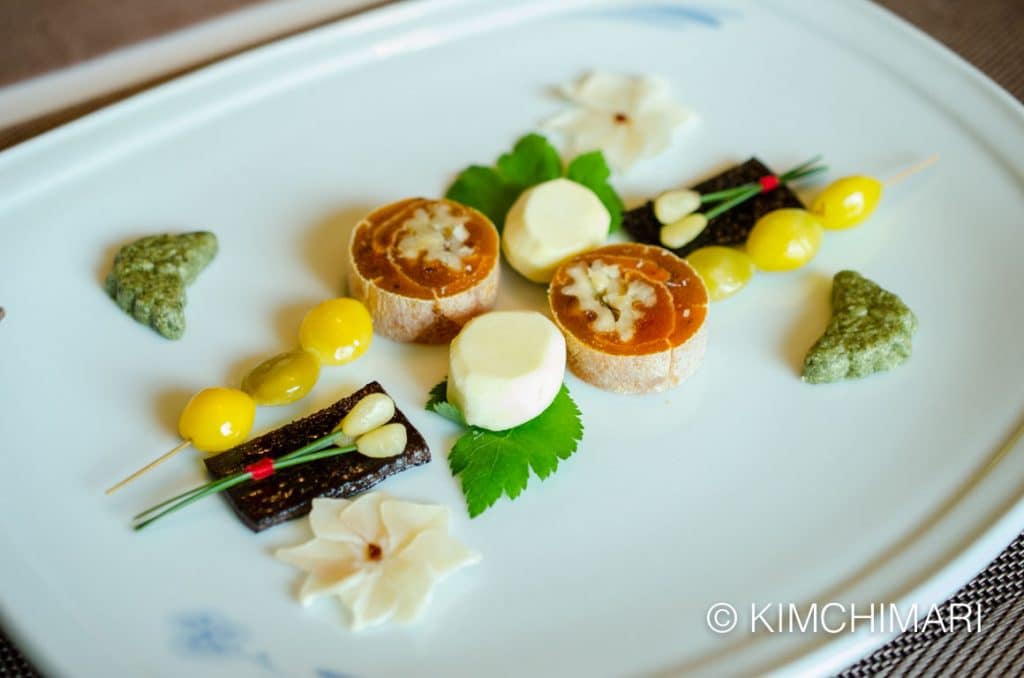
Deluxe Dry Snacks consisting of (left top to right) : pumpkin seed dasik in the shape of butterfly, walnuts rolled in persimmon, raw chestnut with cham namul, 3 gingko nuts skewered, 3 pine nuts on pine needle sticks, Korean beef jerky (육포 Yukpo), and dried octopus flower. Each and every one of these snacks were such a joy to eat. A great mix of nutty, sweet, crunchy, salty and savory flavors. Certainly an exciting start for what’s to come!! Pumpkin seed dasik was extra special to me because I had made dasik before but never with pumpkin seeds. The dried octopus flower (어화 Eohwa) was just so pretty and intriguing as I looked at the backside and realized that the whole flower was carved from one single piece of octopus!
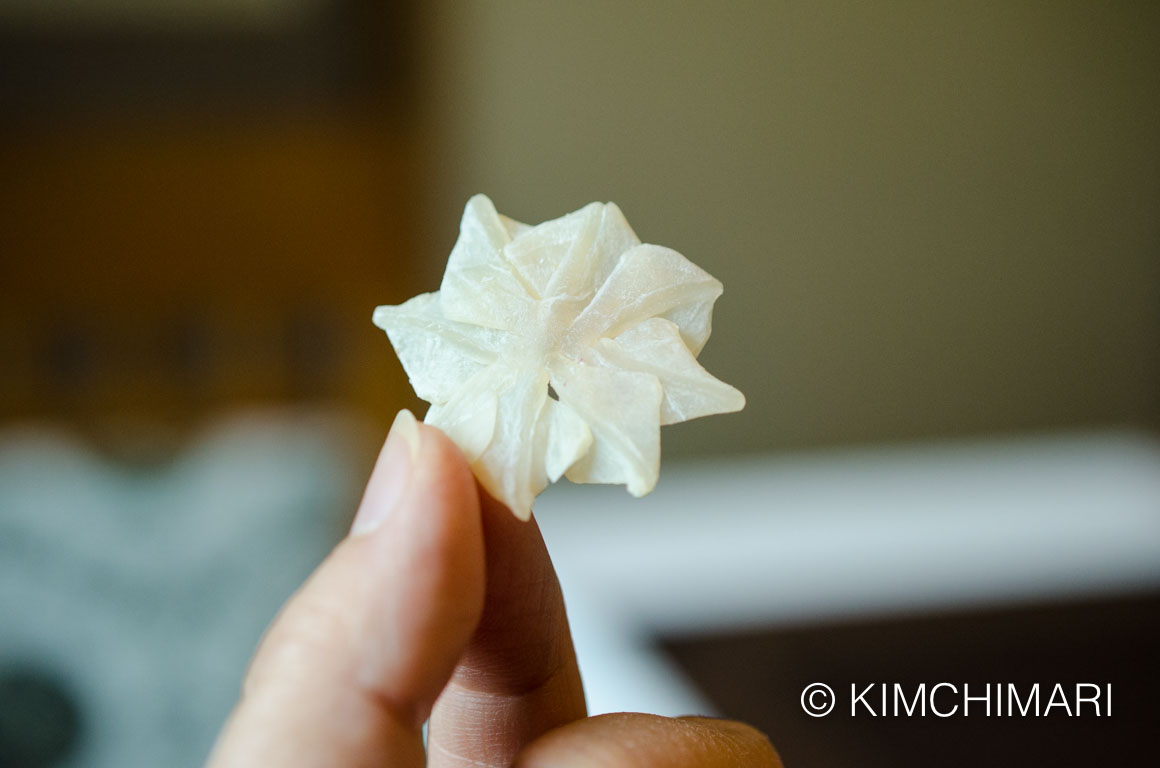
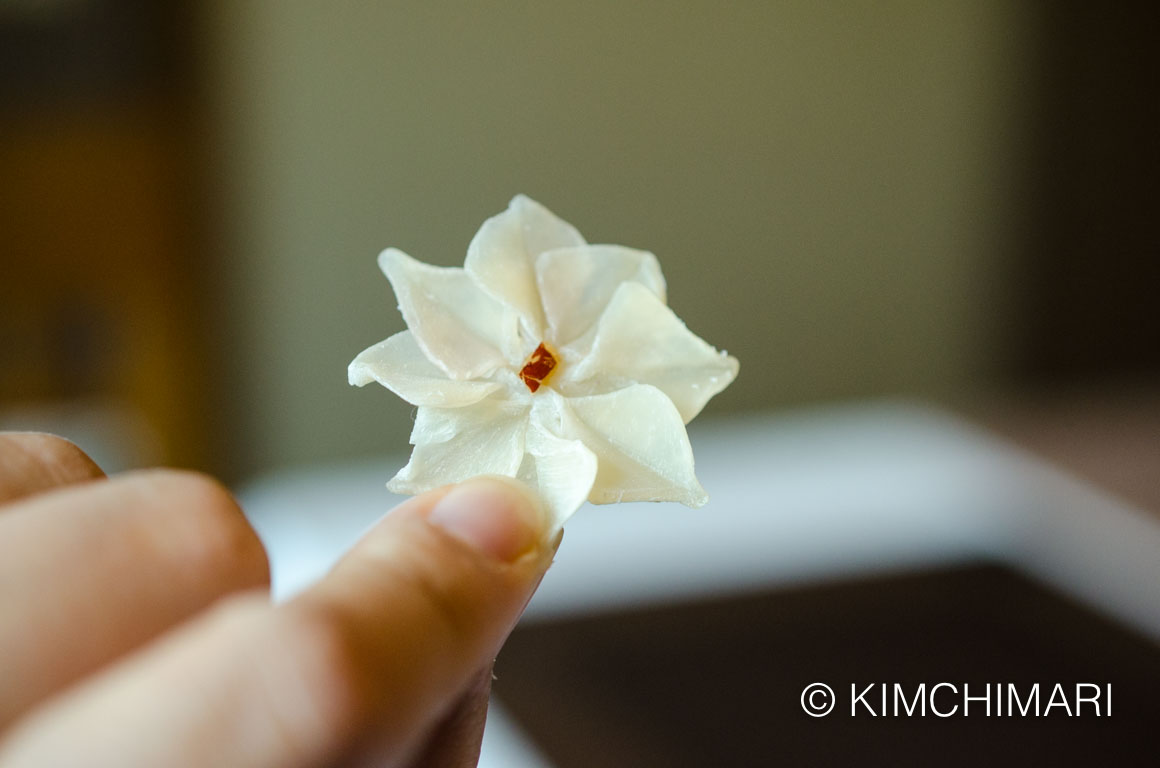
Chrysanthemums and cherry blossoms were often cut out from dried squid and/or octopus and used in Korean royal court cuisine. I saw them in books before but to actually have it served to me was a real treat!
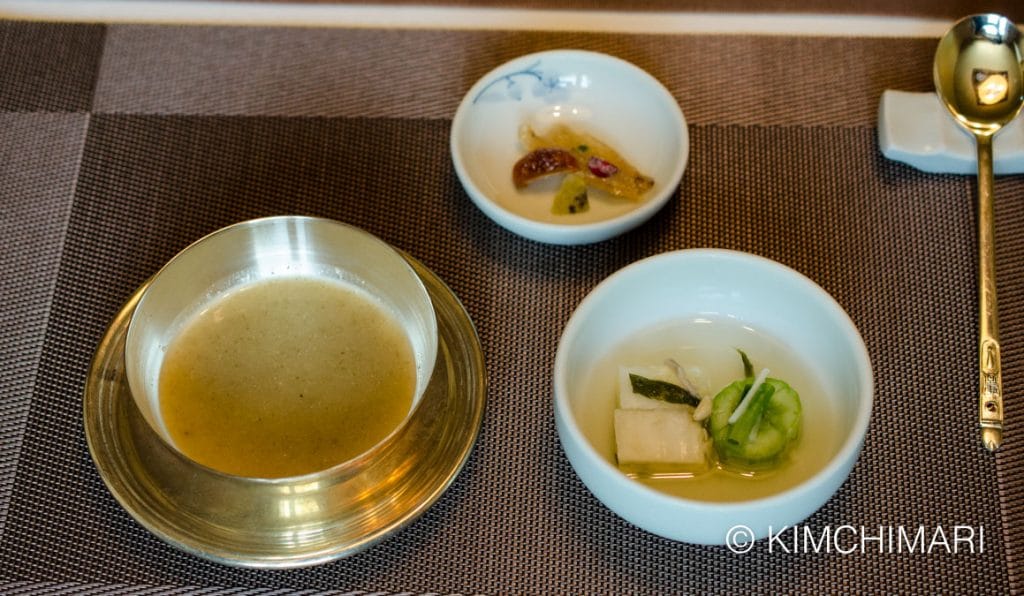
Glutinous Millet Gruel with Water Kimchi was served next with Three Kinds of Candied Fruits . The water kimchi is always such a great palate awakener and I loved having both cucumber and cabbage water kimchi in one bowl. The candied fruits were a great addition of sweetness to what could be kind of a bland porridge (as porridges usually are). The kumquat was wonderful with the rind giving a burst of bitter, sweet and sour flavors. I also loved the rose decor on what I think was doraji but I could be wrong. My memory is kind of fading on that one.
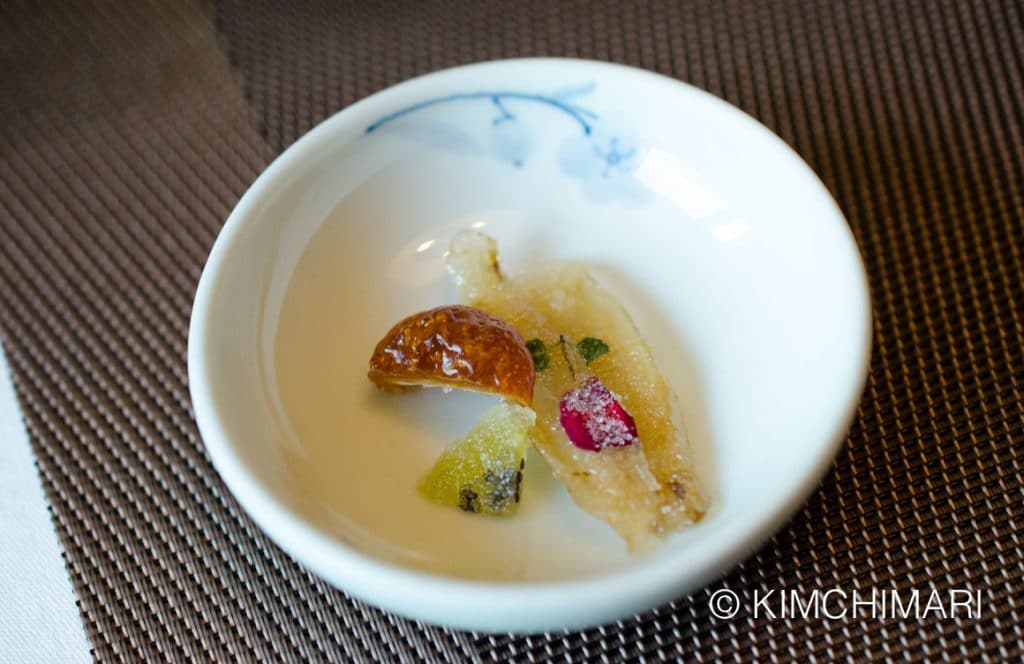
2. Special Delights (진어별미 Jineobyulmi)
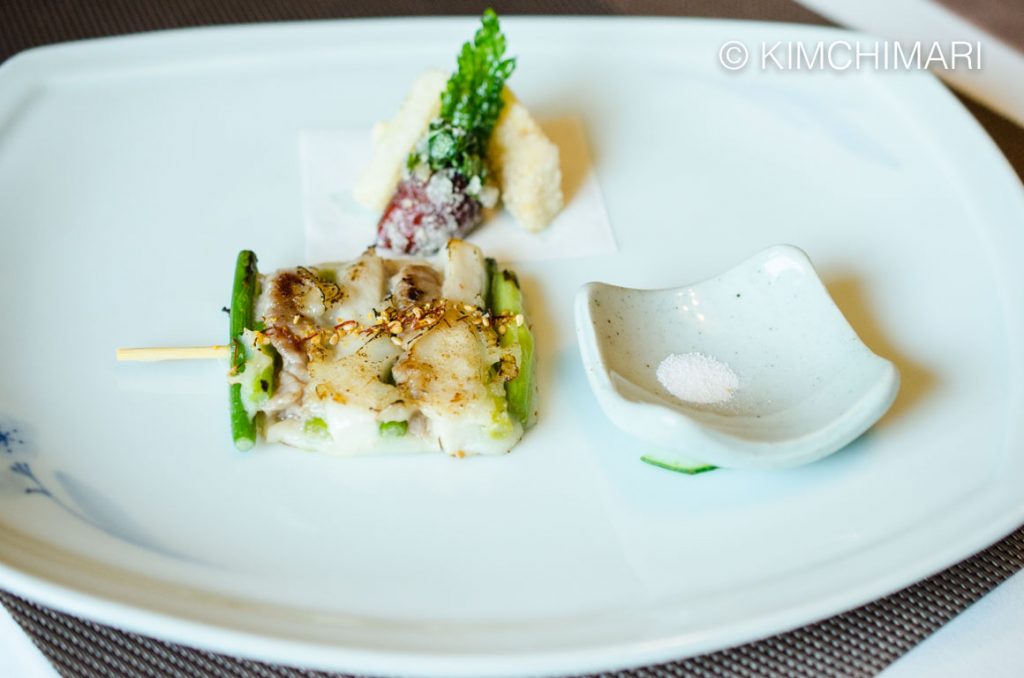
Sanjeok 산적 means skewered something and this was made with beef and garlic scapes which was unusual but was simply lovely. You know how I adore garlic scapes…. 😉 love them any which way.
Deep-fried ginseng was surprisingly yummy with the sea salt, instead of the usual soy sauce. I’m not a real fan of ginseng and especially when it’s served randomly in Korean meals, just to be fancy. But this was really and truly good. Now, the little red root veggie look like thing? Well, it’s actually not a root vegetable but jujube dates rolled with the green leaf (sorry, I forgot what this was) stuffed in the center. That was a lot of work for one mouthful but I certainly appreciated all the handiwork that went into making it. So cute!
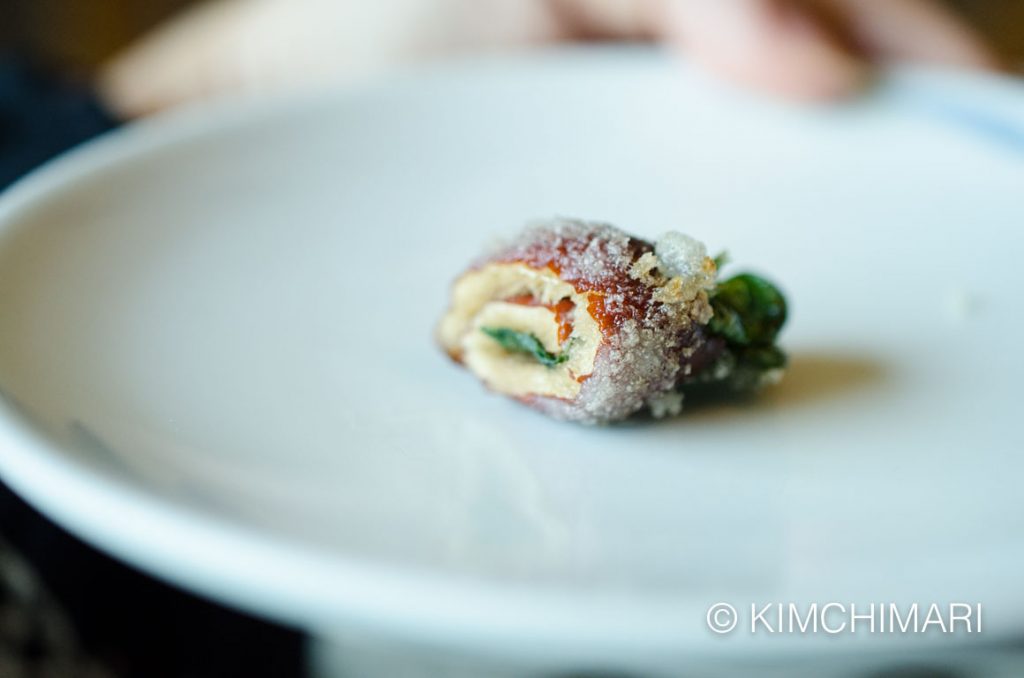
Cold Boiled Beef with Fruit Salad (쇠고기과일편채 Seogogi Kwail Pyeonche)
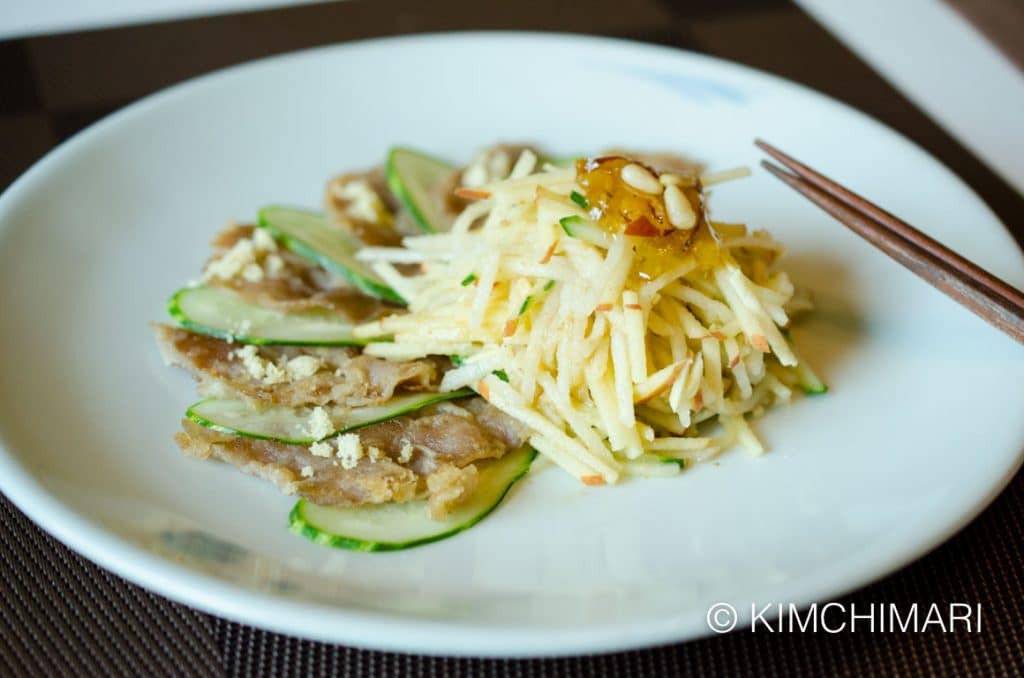
It’s hard to believe that this yummy beef is served cold or rather, at room temperature. I feel like Korean food especially shines with these types of dishes. It’s pretty easy to make meats or veggies taste good when they are served really hot or really cold. But, it’s not easy to create foods that taste good at room temperature. This cool, sweet, refreshing and citrusy fruit salad made with julienned apples and topped with Yuzu Cheong syrup (유자청) matches so incredibly well with the paper thin slices of savory beef and cucumbers. It totally wakes up the flavors of the beef in your mouth. A beautiful balance of fresh and cooked elements that simply brings a smile on your face as you eat it.
3. Seafood Side Dishes (진어소선 Jineososeon)

A lovely rich seafood course of cod fish grilled perfectly with a citron soy sauce glaze, then served sizzling on top of a bed of green onions. Jihwaja has this fantastic way of serving sizzling foods at the table with a live burner candle below which is much like having your own individual chafing dish. I am quite picky about having foods at the right temperature and there’s nothing more delicious than grilled meats and fish served piping hot, still sizzling on the plate and continues to sizzle while you eat.
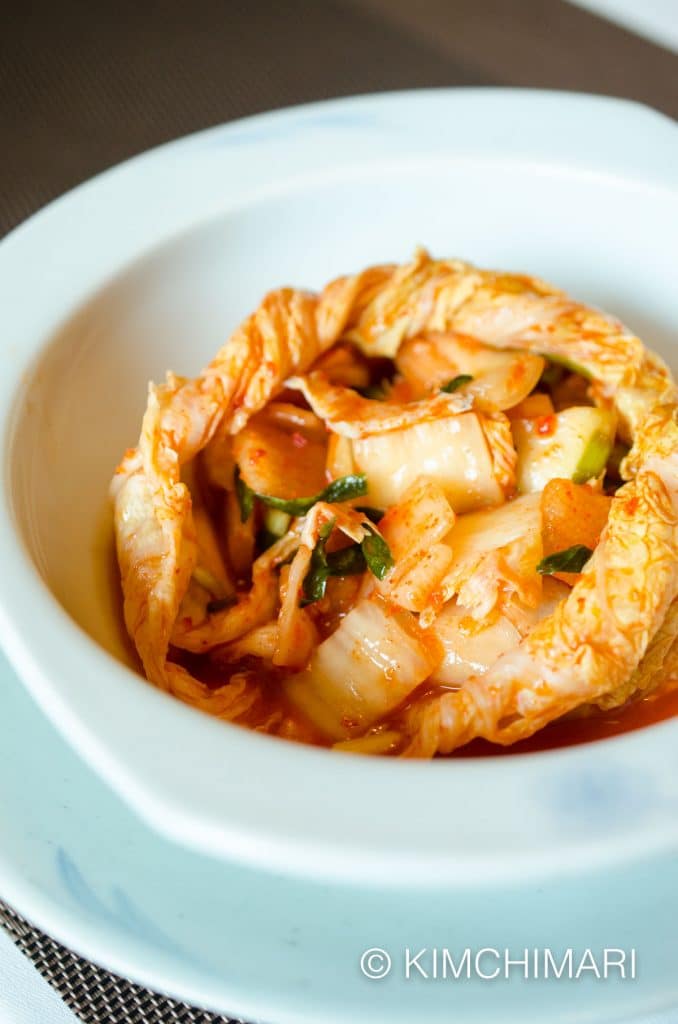
Bo Kimchi 보김치 or sometimes also called Bossam Kimchi. This brought back fond memories of my childhood when my family made it for Kimjang every fall. Unlike most other kimchi, this kimchi wrapped in large cabbage leaves is very delicately seasoned (not at all spicy) with seafoods like abalone, shrimp, baby octopus, and oysters. The fresh seafood adds an extra layer of belly clearing flavor and is the ultimate fancy kimchi that was served mostly for special occasions. Many Korean homes stopped making this scrumptious kimchi because I think it is just too labor intensive to make. So I was very happy to see and taste my old time favorite Kimchi again.
4. Soup (진어별미탕 Jineo Byulmi Tang)
Geumjungtang 금중탕 is a chicken soup with abalone and various vegetables like shitake mushrooms. It comes in a special Korean hot pot, boiling like crazy. The flavors of the broth is so complex because it has seafood, chicken, vegetables and even a little mini meat ball. This dish requires a lot of preparation and is truly a dish fit for the queen filled with ingredients that promote health such as gingko nuts, walnuts and other goodies. I have had Shinseonro 신선로 before which is similar to this but this Geumjungtang was extra yummy because it had my personal favorite – abalone. 😉
5. Sherbet (Jineo Matgashim 진어맛가심)
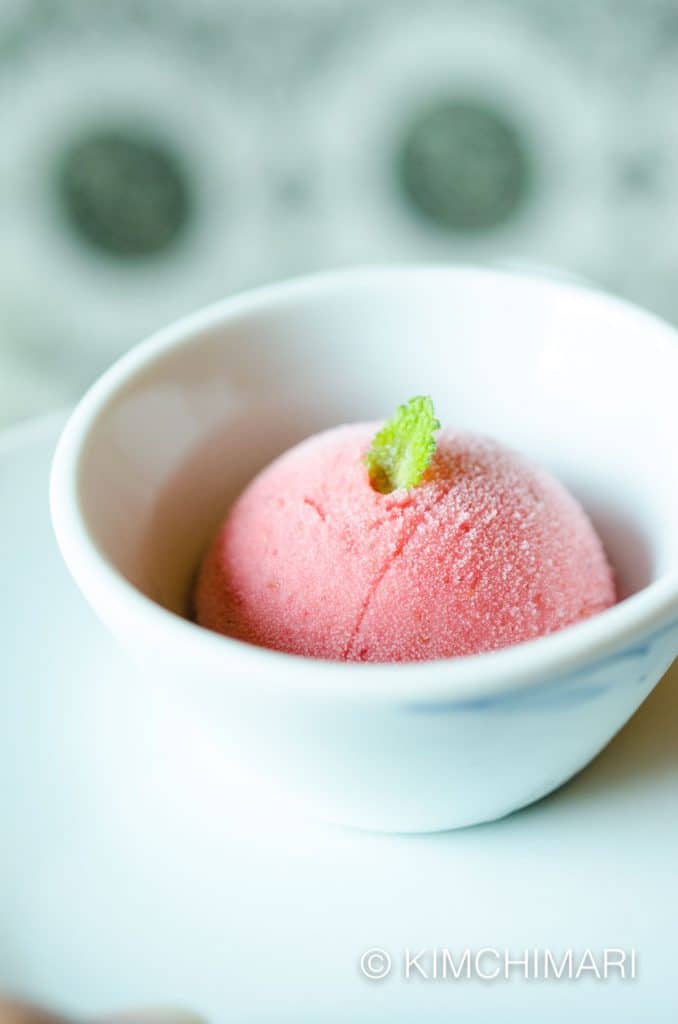
Time for a break! As with any respectable degustation menu, there’s the palate cleanser. I am not sure if this was part of the original banquet meal. 😝 I don’t think they had freezers back then 😜 but it is always a much needed relief after tasting a lot of different flavors.
6. Middle Course (Jineo Daeseon 진어대선)
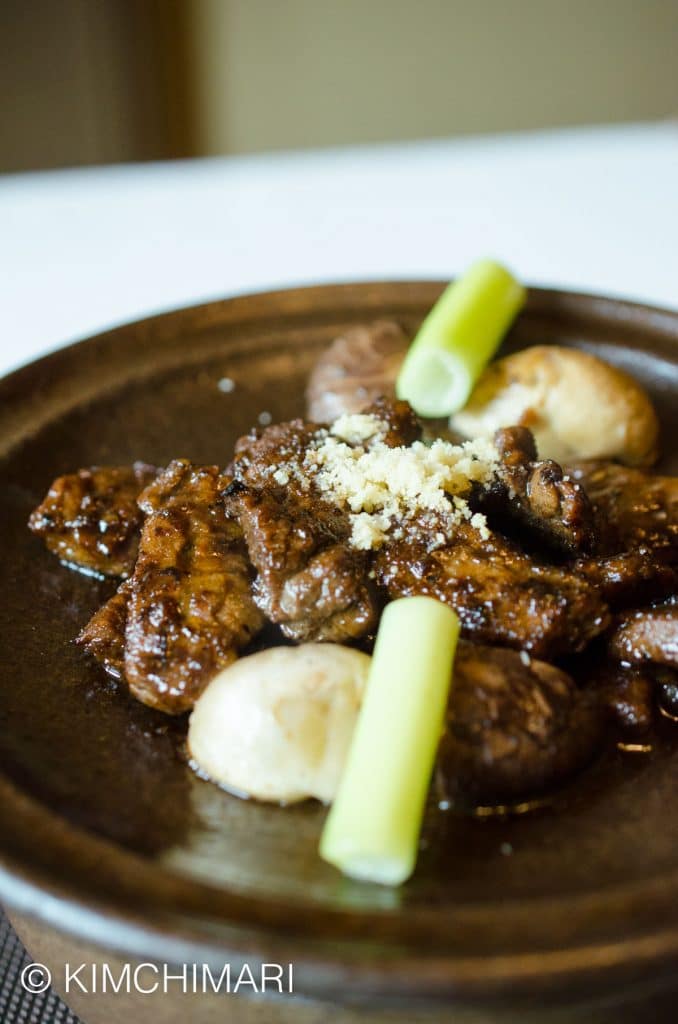
Neobiani Gui (너비아니구이) or marinated beef grilled with Ginseng Vegetable Salad. I think the best way to describe Neobiani Gui is to say that it is a thicker, heavier set cousin of the Bulgogi. It uses basically the same marinade and is also grilled, much like bulgogi. Except the beef is much thicker and thus requires a bit more care – a bit more tenderizing than your regular bulgogi. Although similarly seasoned, it has a totally different texture – having more bite in each mouthful.
With the beef, a Ginseng Vegetable Salad was served to go with it. This is very similar to how I suggested in my latest post that you should make a Green Onion Salad for all your grilled meats, This combination does not just balance the different flavors of heavy vs light but nutritionally, it is also very smartly balanced.
7. Main Course (Jineo Sura 진어수라)
Here you have a choice between Abalone porridge (전복죽 Jeonbokjuk) or Chilled Buckwheat Noodles (배동치미메밀면 Baedongchimi Maemil Myeon). My husband chose the porridge and I chose the cold noodles. When I first saw my noodles, I thought..
“Huh?? Where are the noodles?? I only see white??”
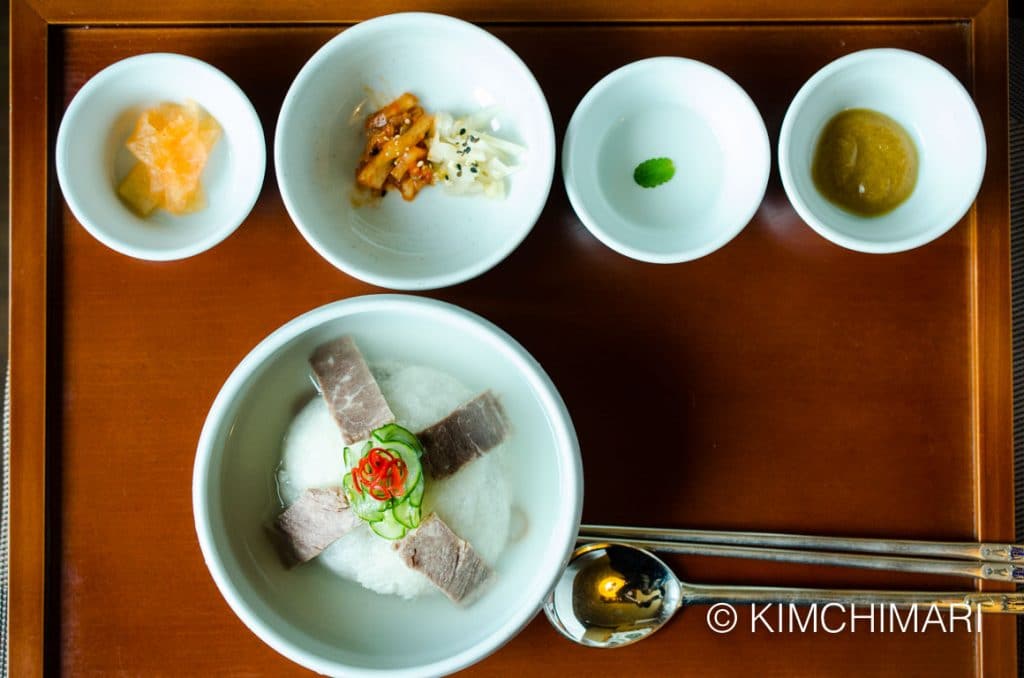
Well, it was because my noodles came fully enveloped in pear served in water kimchi broth!! The server told me that in the old days, instead of cutting the pear with a knife, the royal chefs used spoons to spoon out the pear which is said to preserve the juice and texture better. Simply genius. So loved this noodle dish. And here it is uncovered!
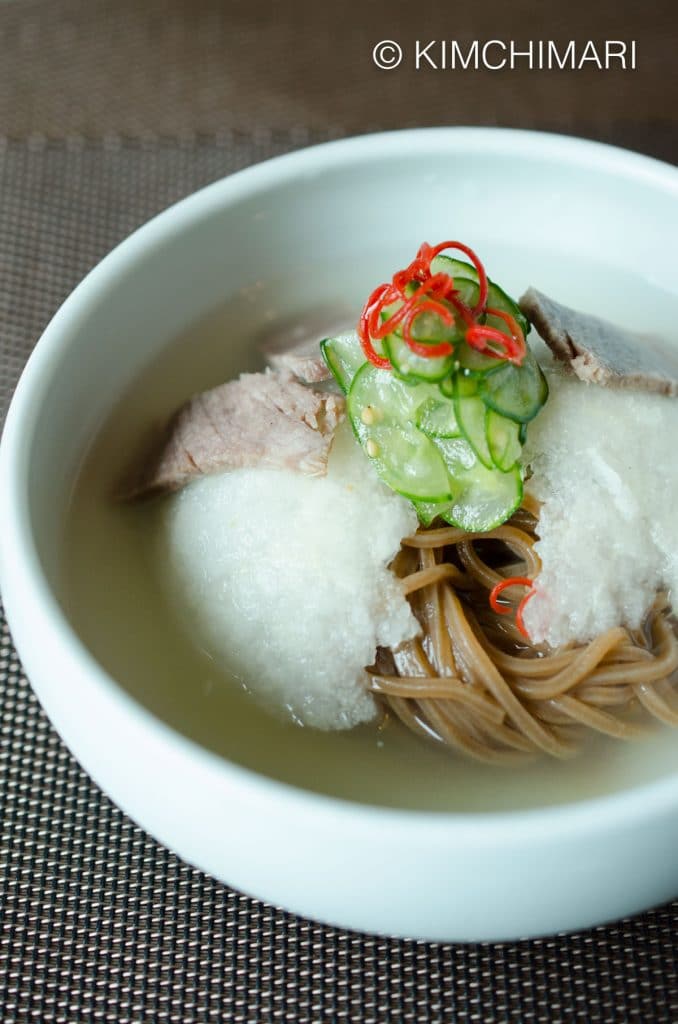
Wow, my mouth is watering just as I am seeing this now… This cold noodles is sort of like the common Naengmyeon but OH-SO-MUCH-MORE delicate, soothing and clearing. Good stuff..
8. Dessert (다과 Dagwa)
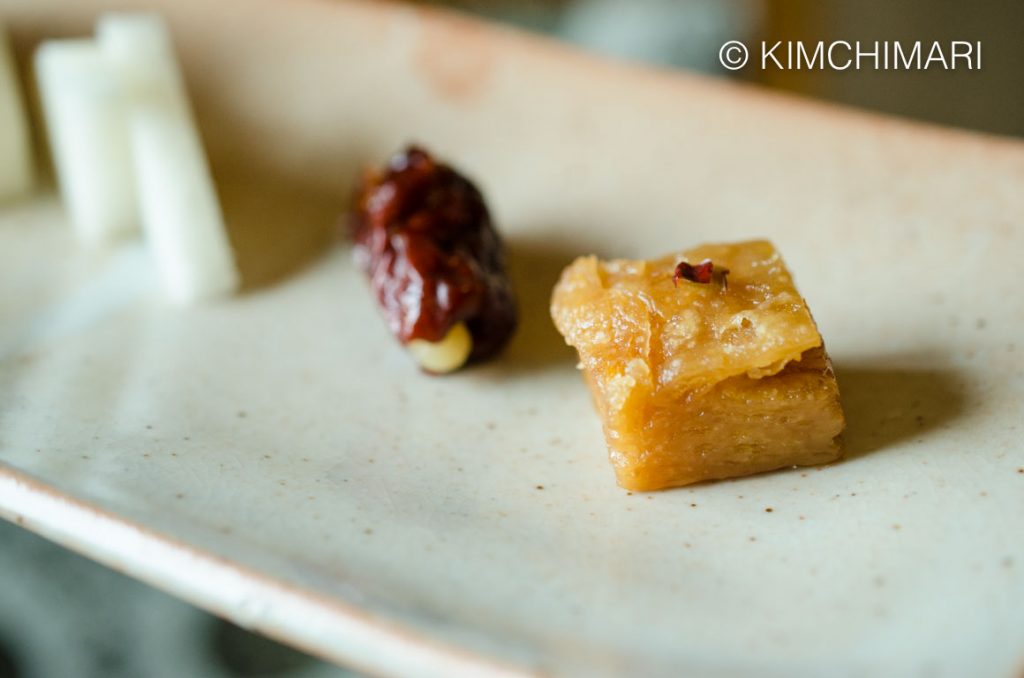
There was a plate of 4 different things on the dessert plate – 2 fruits, jujube date and Yakwa. Now the Yakwa deserves my special attention!! WHY?? Because it was just as good as how my mother-in-law makes it and thus is how I make it. So there’s a bit of crunchiness left in my recipe whereas this one just totally disappears in your mouth. And if you read my Story of Yakwa and Yaksik post, you will understand why my husband’s family can say they know more about how a proper Yakwa is made than anyone else.
Many fancy Korean restaurants make and serve Yakwa (Yakgwa) but very few actually gets it right. Notice how this one has many layers like a mille feuille or baklava which is the way it should be. THANK YOU to Hwang family for keeping this tradition alive!!
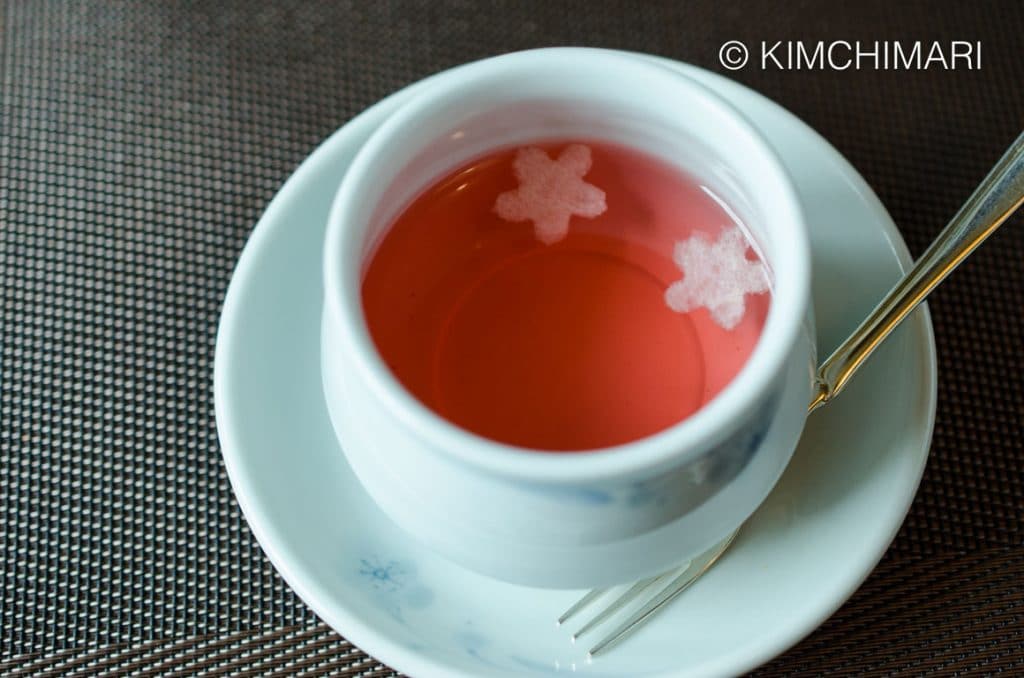
A sweet finish to a sweet and spectacular lunch was this Omija Hwachae 오미자 화채. Omija is a five flavor berry that has sweet, sour, tart, spicy and salty flavors but when it is mixed with sugar or honey, it smooths out the taste and makes a great thirst quenching drink for the summer.
Well, hope you enjoyed your time travel to the days in the royal court when food was prepared with a purpose, to promote the happiness and well being of Kings and Queens. If you ever visit Seoul, I hope you can visit this restaurant. The Korean royal court cuisine food served here is delicate and elegant with the seasoning not overpowering the ingredients. You also hear detailed explanation of each menu item as they are served which makes it even more enjoyable. BTW, they also have a la carte menu so you can go for that if you don’t want a full course meal.
Be well my friends!!
XOXO ❤
JinJoo
Jihwaja 지화자
125 Jahamun-ro, Jongno-gu, Seoul, Korea Reservation: 02.2269.5834 Email: jihwaja (at) jihwajafood.co.kr
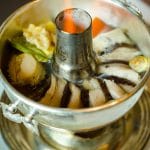
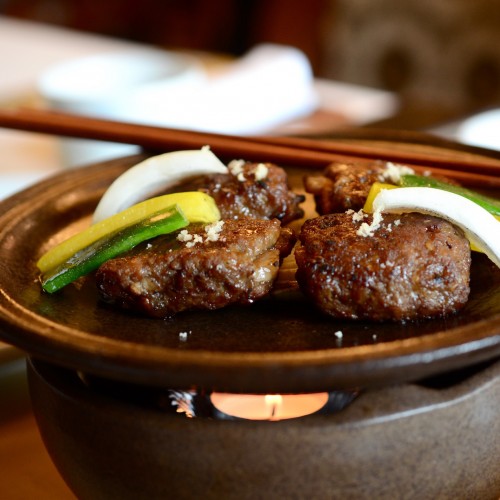
















oh, I just saw that you commented you have had halva! that’s great! there are even types that are made with grains — in Turkey, they make it with semolina! but I prefer sesame/pistachio the best. there are 녹차 flavored ones, too (usually called “matcha,” because at least in the U.S., because people here are more familiar with the Japanese term. eat well!
I also would have thought that noodle course was 막국수 if not for your explanation! I really enjoy reading and learning from you. thank you! and I hope you like halva! it’s REALLY good when covered in chocolate, too… but that’s the kind kids eat. 🙂
wonderful! the 다식 recipe is so similar to how sesame halva is made — we just start with tahini (pre-ground sesame seed paste). I will definitely try your recipe! thank you.
I mean your 다식 recipe, of course. I’d LOVE to try pumpkin seed and pine pollen 다식! with halva, my favorite flavor is vanilla with chopped pistachios added.
OH! I actually have had Halva before. I just didn’t know the name. It was very yummy. Oooh vanilla and chopped pistachios added would be really good. Love pistachios… thanks for mentioning this!
That’s so interesting! I will have to look up sesame halva.. Thank you for leaving me a comment.
You look very beautiful, elegant and entirely regal in your husband’s photo’ JinJoo.. and no dishwash hands either!!!
So interesting, is there a specific Korean Temple food aswell?